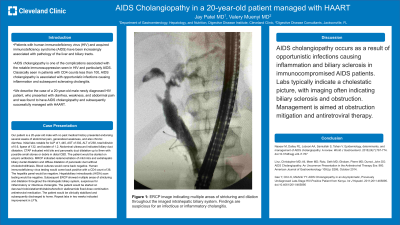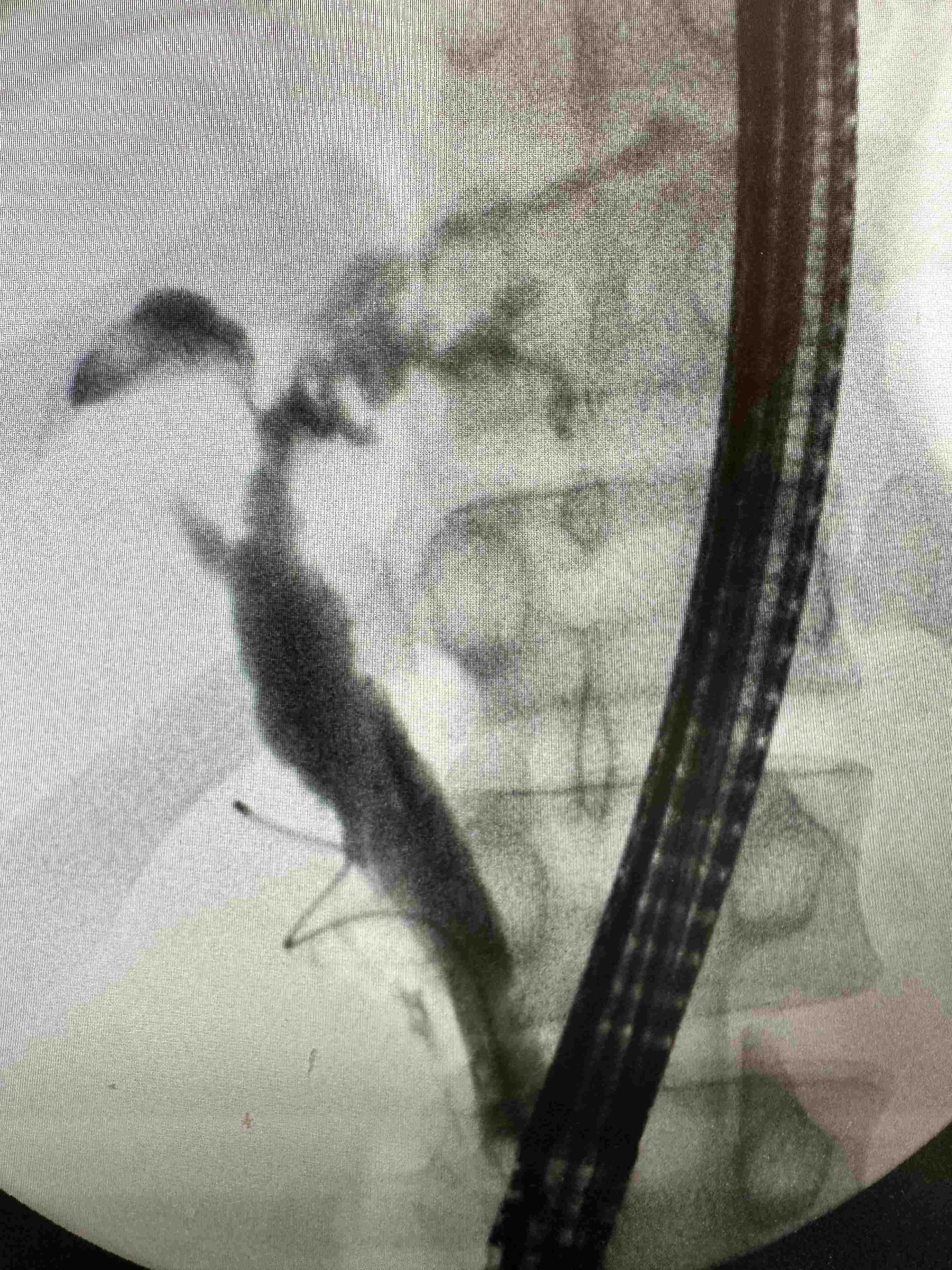Sunday Poster Session
Category: Liver
P1019 - AIDS Cholangiopathy in a 20-Year-Old Patient Managed With HAART
Sunday, October 22, 2023
3:30 PM - 7:00 PM PT
Location: Exhibit Hall

Has Audio
- JP
Jay Patel, MD
Orange Park Medical Center
Cleveland, OH
Presenting Author(s)
Jay Patel, MD1, Valery Muenyi, MD2
1Orange Park Medical Center, Jacksonville, FL; 2Digestive Disease Consultants, Jacksonville, FL
Introduction: Patients with human immunodeficiency virus(HIV) and acquired immunodeficiency syndrome(AIDS) have been increasingly associated with pathology of the liver and biliary tracts. AIDS cholangiopathy is one of the complications associated with the notable immunosuppression seen in HIV and particularly AIDS. Classically seen in patients with CD4 counts less than 100, AIDS cholangiopathy is associated with opportunistic infections causing inflammation and subsequent sclerosing cholangitis. Although not as common in developing nations with the advent of highly active antiretroviral therapy (HAART), AIDS cholangitis can be frequently seen in developing nations and in severely immunosuppressed patients. We describe the case of a 20-year-old male with newly diagnosed AIDS, who presented with diarrhea, weakness, and abdominal pain and was found to have AIDS cholangiopathy and subsequently successfully managed with antiretroviral therapy.
Case Description/Methods: Our patient is a 20-year-old male with no significant past medical history who presented endorsing several weeks of intermittent abdominal pain and generalized weakness. Initial labs were notable for a alkaline phosphatase of 1,445, aspartate transaminase of 302, alanine aminotransferase of 238, total bilirubin of 0.6, and lipase of 132. Utrasound indicated biliary duct dilatation. Computed tomography of the abdomen/pelvis indicated bile and pancreatic duct dilatation. Magnetic resonance cholangiopancreatography (MRCP) indicated intra and extrahepatic biliary ductal dilatation and diffuse dilatation of pancreatic duct without choledocholithiasis. Human immunodeficiency virus testing would come back positive with a CD4 count of 36 and hepatitis testing negative. Endoscopic retrograde cholangiopancreatography(ERCP) showed multiple areas of stricturing and dilatation throughout the intrahepatic biliary system, suspicious for inflammatory or infectious cholangitis. The patient would be started on combination antiretroviral medication. The patient would be clinically stabilized and subsequently discharged to home. Repeat labs in two weeks indicated improvement in liver function tests (LFTs).
Discussion: AIDS cholangiopathy occurs as a result of opportunistic infections causing inflammation and biliary sclerosis in immunocompromised AIDS patients. Labs typically indicate a cholestatic picture, with imaging often indicating biliary sclerosis and obstruction. Management is aimed at obstruction mitigation and antiretroviral therapy.

Disclosures:
Jay Patel, MD1, Valery Muenyi, MD2. P1019 - AIDS Cholangiopathy in a 20-Year-Old Patient Managed With HAART, ACG 2023 Annual Scientific Meeting Abstracts. Vancouver, BC, Canada: American College of Gastroenterology.
1Orange Park Medical Center, Jacksonville, FL; 2Digestive Disease Consultants, Jacksonville, FL
Introduction: Patients with human immunodeficiency virus(HIV) and acquired immunodeficiency syndrome(AIDS) have been increasingly associated with pathology of the liver and biliary tracts. AIDS cholangiopathy is one of the complications associated with the notable immunosuppression seen in HIV and particularly AIDS. Classically seen in patients with CD4 counts less than 100, AIDS cholangiopathy is associated with opportunistic infections causing inflammation and subsequent sclerosing cholangitis. Although not as common in developing nations with the advent of highly active antiretroviral therapy (HAART), AIDS cholangitis can be frequently seen in developing nations and in severely immunosuppressed patients. We describe the case of a 20-year-old male with newly diagnosed AIDS, who presented with diarrhea, weakness, and abdominal pain and was found to have AIDS cholangiopathy and subsequently successfully managed with antiretroviral therapy.
Case Description/Methods: Our patient is a 20-year-old male with no significant past medical history who presented endorsing several weeks of intermittent abdominal pain and generalized weakness. Initial labs were notable for a alkaline phosphatase of 1,445, aspartate transaminase of 302, alanine aminotransferase of 238, total bilirubin of 0.6, and lipase of 132. Utrasound indicated biliary duct dilatation. Computed tomography of the abdomen/pelvis indicated bile and pancreatic duct dilatation. Magnetic resonance cholangiopancreatography (MRCP) indicated intra and extrahepatic biliary ductal dilatation and diffuse dilatation of pancreatic duct without choledocholithiasis. Human immunodeficiency virus testing would come back positive with a CD4 count of 36 and hepatitis testing negative. Endoscopic retrograde cholangiopancreatography(ERCP) showed multiple areas of stricturing and dilatation throughout the intrahepatic biliary system, suspicious for inflammatory or infectious cholangitis. The patient would be started on combination antiretroviral medication. The patient would be clinically stabilized and subsequently discharged to home. Repeat labs in two weeks indicated improvement in liver function tests (LFTs).
Discussion: AIDS cholangiopathy occurs as a result of opportunistic infections causing inflammation and biliary sclerosis in immunocompromised AIDS patients. Labs typically indicate a cholestatic picture, with imaging often indicating biliary sclerosis and obstruction. Management is aimed at obstruction mitigation and antiretroviral therapy.

Figure: Endoscopic retrograde cholangiopancreatography indicating multiple areas of stricturing and dilatation throughout the intrahepatic biliary system.
Disclosures:
Jay Patel indicated no relevant financial relationships.
Valery Muenyi indicated no relevant financial relationships.
Jay Patel, MD1, Valery Muenyi, MD2. P1019 - AIDS Cholangiopathy in a 20-Year-Old Patient Managed With HAART, ACG 2023 Annual Scientific Meeting Abstracts. Vancouver, BC, Canada: American College of Gastroenterology.
